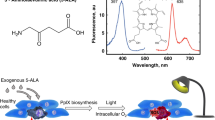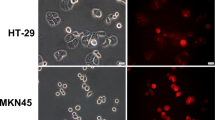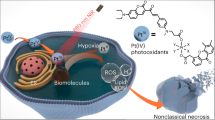Abstract
5-Aminolaevulinic acid (ALA)-induced porphyrin biosynthesis and phototoxicity in vitro was investigated in five malignant and two normal cell lines. Intracellular protoporphyrin IX (PpIX) content was quantified by extraction and fluorescence spectroscopy. Cellular PpIX content did not always correlate with cell proliferation rate as measured by the doubling times of cell lines. Cellular efflux of PpIX was also investigated. In a bladder carcinoma cell line, the observed rapid efflux was not blocked by verapamil, an inhibitor of the P-glycoprotein efflux pump. These data support the view that cellular PpIX accumulation is a dynamic process that is determined by both the efflux of PpIX from the cells and enzyme activities in the haem biosynthesis pathway. Desferrioxamine (desferal), a modulator of PpIX biosynthesis, enhanced ALA-induced cellular PpIX content significantly in all carcinoma cell lines but not in non-malignant cell lines. The enhanced PpIX cellular accumulation is attributed to inhibition of ferrochelatase activity, the enzyme responsible for the conversion of PpIX to haem. PpIX-mediated cellular photodestruction following irradiation with an argon ion laser at 514.5 nm was determined by the 'MTT assay'. There appeared to be a 'threshold' effect of cellular PpIX content; cells that synthesised less than 140 ng/mg-1 protein exhibited very little phototoxic damage, while cell lines having greater than 140 ng PpIX/mg-1 protein [corrected] exhibited a consistent phototoxic response. Among the cell lines which did undergo phototoxic damage, there was not a strict correlation between PpIX cellular content and ALA-induced phototoxicity. Desferal enhanced the PpIX content and phototoxic effect in the responsive cells. Fluorescence microscopy of the ALA-treated cells revealed marked accumulation of PpIX in mitochondria (rhodamine 123 co-staining). That the primary site of phototoxic damage is also the mitochondria was confirmed by electron micrographs of cells photosensitised with ALA-induced PpIX, which showed swelling of mitochondria within minutes after irradiation while other suborganelles appeared to be unaffected. The repair or further destruction of the mitochondria was fluence and cell-type dependent. The data from this study suggest that the basis of increased ALA-induced PpIX accumulation in tumours is a combination of various aspects of the metabolic process and pharmacokinetics and that the efficacy of photodestruction of malignancy will be determined not only by the rate of PpIX synthesis but also by specific cellular and tissue characteristics.
This is a preview of subscription content, access via your institution
Access options
Subscribe to this journal
Receive 24 print issues and online access
$259.00 per year
only $10.79 per issue
Buy this article
- Purchase on Springer Link
- Instant access to full article PDF
Prices may be subject to local taxes which are calculated during checkout
Similar content being viewed by others
Author information
Authors and Affiliations
Rights and permissions
About this article
Cite this article
Iinuma, S., Farshi, S., Ortel, B. et al. A mechanistic study of cellular photodestruction with 5-aminolaevulinic acid-induced porphyrin. Br J Cancer 70, 21–28 (1994). https://doi.org/10.1038/bjc.1994.244
Issue Date:
DOI: https://doi.org/10.1038/bjc.1994.244
This article is cited by
-
Photodynamische Therapie – aktuelle Trends
hautnah (2023)
-
Comparing desferrioxamine and light fractionation enhancement of ALA-PpIX photodynamic therapy in skin cancer
British Journal of Cancer (2016)
-
Low-Dose Topical 5-Aminolevulinic Acid Photodynamic Therapy in the Treatment of Different Severity of Acne Vulgaris
Cell Biochemistry and Biophysics (2015)
-
Accumulation and Elimination of Photosens and Protoporphyrin IX by Different Types of Mesenchymal Cells
Bulletin of Experimental Biology and Medicine (2013)
-
Intraoperative 5-aminolevulinic-acid-induced fluorescence in meningiomas
Acta Neurochirurgica (2010)



